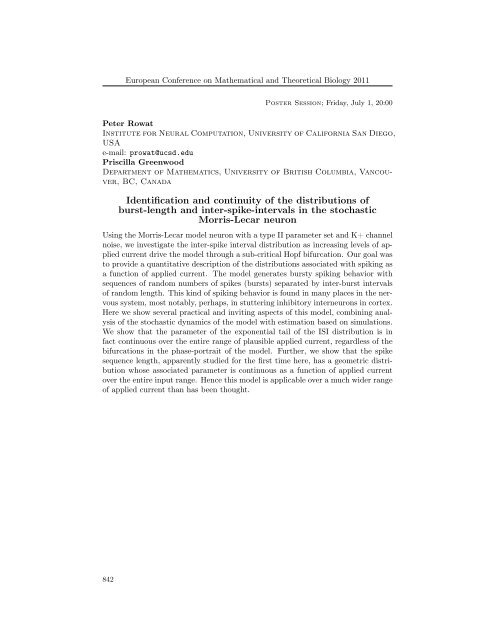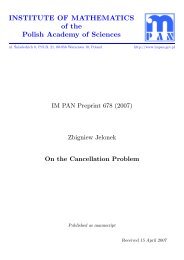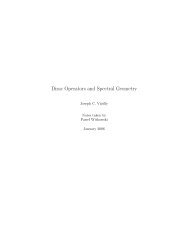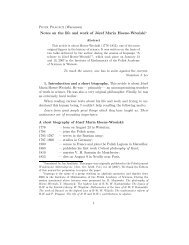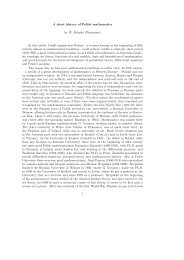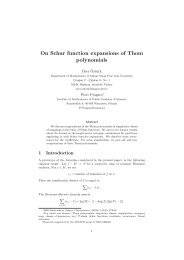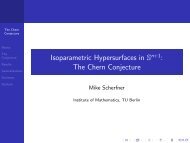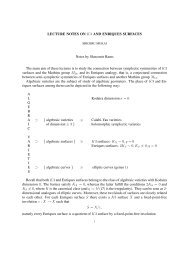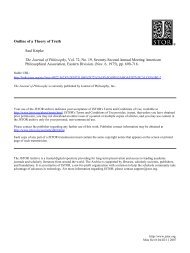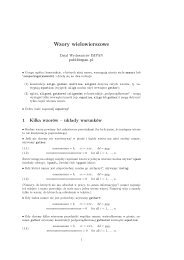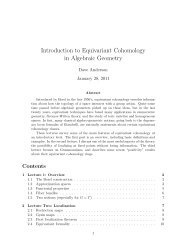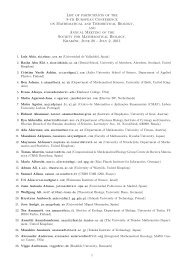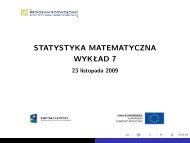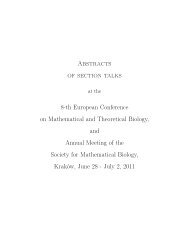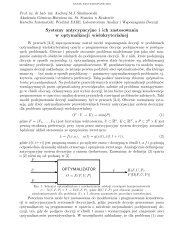Abstracts of Posters 8-th European Conference on Mathematical ...
Abstracts of Posters 8-th European Conference on Mathematical ...
Abstracts of Posters 8-th European Conference on Mathematical ...
You also want an ePaper? Increase the reach of your titles
YUMPU automatically turns print PDFs into web optimized ePapers that Google loves.
<str<strong>on</strong>g>European</str<strong>on</strong>g> <str<strong>on</strong>g>C<strong>on</strong>ference</str<strong>on</strong>g> <strong>on</strong> Ma<str<strong>on</strong>g>th</str<strong>on</strong>g>ematical and Theoretical Biology 2011<br />
Poster Sessi<strong>on</strong>; Friday, July 1, 20:00<br />
Peter Rowat<br />
Institute for Neural Computati<strong>on</strong>, University <str<strong>on</strong>g>of</str<strong>on</strong>g> California San Diego,<br />
USA<br />
e-mail: prowat@ucsd.edu<br />
Priscilla Greenwood<br />
Department <str<strong>on</strong>g>of</str<strong>on</strong>g> Ma<str<strong>on</strong>g>th</str<strong>on</strong>g>ematics, University <str<strong>on</strong>g>of</str<strong>on</strong>g> British Columbia, Vancouver,<br />
BC, Canada<br />
Identificati<strong>on</strong> and c<strong>on</strong>tinuity <str<strong>on</strong>g>of</str<strong>on</strong>g> <str<strong>on</strong>g>th</str<strong>on</strong>g>e distributi<strong>on</strong>s <str<strong>on</strong>g>of</str<strong>on</strong>g><br />
burst-leng<str<strong>on</strong>g>th</str<strong>on</strong>g> and inter-spike-intervals in <str<strong>on</strong>g>th</str<strong>on</strong>g>e stochastic<br />
Morris-Lecar neur<strong>on</strong><br />
Using <str<strong>on</strong>g>th</str<strong>on</strong>g>e Morris-Lecar model neur<strong>on</strong> wi<str<strong>on</strong>g>th</str<strong>on</strong>g> a type II parameter set and K+ channel<br />
noise, we investigate <str<strong>on</strong>g>th</str<strong>on</strong>g>e inter-spike interval distributi<strong>on</strong> as increasing levels <str<strong>on</strong>g>of</str<strong>on</strong>g> applied<br />
current drive <str<strong>on</strong>g>th</str<strong>on</strong>g>e model <str<strong>on</strong>g>th</str<strong>on</strong>g>rough a sub-critical Hopf bifurcati<strong>on</strong>. Our goal was<br />
to provide a quantitative descripti<strong>on</strong> <str<strong>on</strong>g>of</str<strong>on</strong>g> <str<strong>on</strong>g>th</str<strong>on</strong>g>e distributi<strong>on</strong>s associated wi<str<strong>on</strong>g>th</str<strong>on</strong>g> spiking as<br />
a functi<strong>on</strong> <str<strong>on</strong>g>of</str<strong>on</strong>g> applied current. The model generates bursty spiking behavior wi<str<strong>on</strong>g>th</str<strong>on</strong>g><br />
sequences <str<strong>on</strong>g>of</str<strong>on</strong>g> random numbers <str<strong>on</strong>g>of</str<strong>on</strong>g> spikes (bursts) separated by inter-burst intervals<br />
<str<strong>on</strong>g>of</str<strong>on</strong>g> random leng<str<strong>on</strong>g>th</str<strong>on</strong>g>. This kind <str<strong>on</strong>g>of</str<strong>on</strong>g> spiking behavior is found in many places in <str<strong>on</strong>g>th</str<strong>on</strong>g>e nervous<br />
system, most notably, perhaps, in stuttering inhibitory interneur<strong>on</strong>s in cortex.<br />
Here we show several practical and inviting aspects <str<strong>on</strong>g>of</str<strong>on</strong>g> <str<strong>on</strong>g>th</str<strong>on</strong>g>is model, combining analysis<br />
<str<strong>on</strong>g>of</str<strong>on</strong>g> <str<strong>on</strong>g>th</str<strong>on</strong>g>e stochastic dynamics <str<strong>on</strong>g>of</str<strong>on</strong>g> <str<strong>on</strong>g>th</str<strong>on</strong>g>e model wi<str<strong>on</strong>g>th</str<strong>on</strong>g> estimati<strong>on</strong> based <strong>on</strong> simulati<strong>on</strong>s.<br />
We show <str<strong>on</strong>g>th</str<strong>on</strong>g>at <str<strong>on</strong>g>th</str<strong>on</strong>g>e parameter <str<strong>on</strong>g>of</str<strong>on</strong>g> <str<strong>on</strong>g>th</str<strong>on</strong>g>e exp<strong>on</strong>ential tail <str<strong>on</strong>g>of</str<strong>on</strong>g> <str<strong>on</strong>g>th</str<strong>on</strong>g>e ISI distributi<strong>on</strong> is in<br />
fact c<strong>on</strong>tinuous over <str<strong>on</strong>g>th</str<strong>on</strong>g>e entire range <str<strong>on</strong>g>of</str<strong>on</strong>g> plausible applied current, regardless <str<strong>on</strong>g>of</str<strong>on</strong>g> <str<strong>on</strong>g>th</str<strong>on</strong>g>e<br />
bifurcati<strong>on</strong>s in <str<strong>on</strong>g>th</str<strong>on</strong>g>e phase-portrait <str<strong>on</strong>g>of</str<strong>on</strong>g> <str<strong>on</strong>g>th</str<strong>on</strong>g>e model. Fur<str<strong>on</strong>g>th</str<strong>on</strong>g>er, we show <str<strong>on</strong>g>th</str<strong>on</strong>g>at <str<strong>on</strong>g>th</str<strong>on</strong>g>e spike<br />
sequence leng<str<strong>on</strong>g>th</str<strong>on</strong>g>, apparently studied for <str<strong>on</strong>g>th</str<strong>on</strong>g>e first time here, has a geometric distributi<strong>on</strong><br />
whose associated parameter is c<strong>on</strong>tinuous as a functi<strong>on</strong> <str<strong>on</strong>g>of</str<strong>on</strong>g> applied current<br />
over <str<strong>on</strong>g>th</str<strong>on</strong>g>e entire input range. Hence <str<strong>on</strong>g>th</str<strong>on</strong>g>is model is applicable over a much wider range<br />
<str<strong>on</strong>g>of</str<strong>on</strong>g> applied current <str<strong>on</strong>g>th</str<strong>on</strong>g>an has been <str<strong>on</strong>g>th</str<strong>on</strong>g>ought.<br />
842


